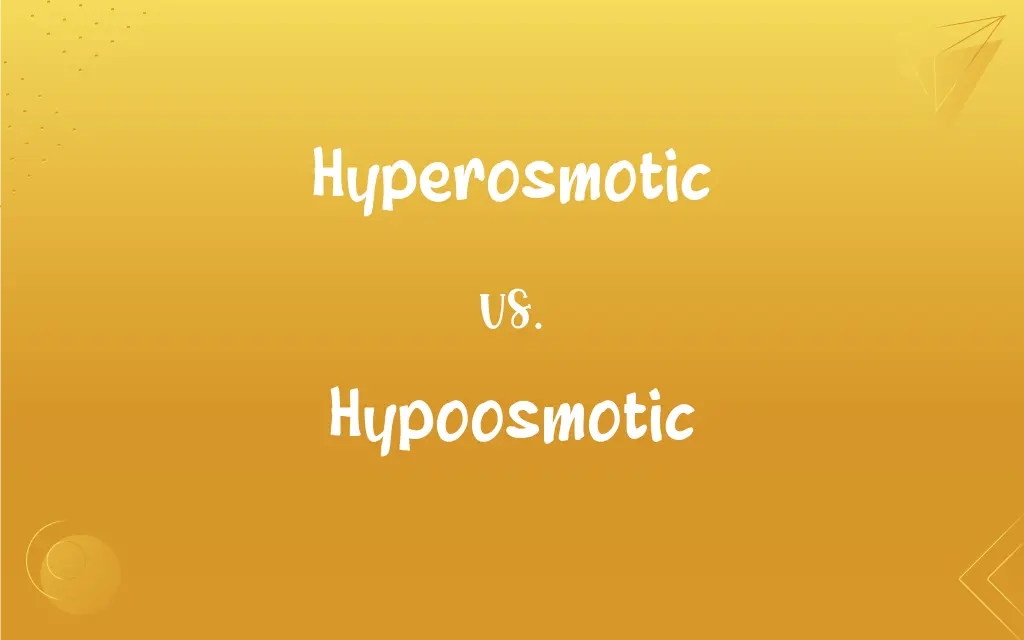Hyperosmotic vs. Hypoosmotic: What's the Difference?
By Harlon Moss & Janet White || Published on March 19, 2024
Hyperosmotic solutions have a higher solute concentration than another solution, whereas hypoosmotic solutions have a lower solute concentration.

Key Differences
Hyperosmotic and hypoosmotic conditions are terms used to describe the osmolarity of one solution relative to another, focusing on the solute concentration. A hyperosmotic solution has a higher concentration of solutes compared to the reference solution, leading to a potential movement of water towards the hyperosmotic side to achieve osmotic balance. In contrast, a hypoosmotic solution has a lower concentration of solutes, which can cause water to move out of this solution into the area of higher solute concentration.
In biological contexts, the osmotic condition of the environment can significantly affect cell function and health. Cells placed in a hyperosmotic solution tend to lose water to the environment, potentially leading to cell shrinkage or crenation. Conversely, cells in a hypoosmotic solution may absorb water, swelling or even bursting in extreme cases, a condition known as lysis.
The regulation of osmolarity is critical for organisms to maintain homeostasis. For example, the kidneys play a vital role in regulating the osmolarity of blood plasma, ensuring it does not become too hyperosmotic or hypoosmotic relative to the cells of the body. Plants also manage osmotic conditions through structures like stomata, which help control water loss and uptake.
Hyperosmotic and hypoosmotic conditions are not only important in biology but also in medical and laboratory settings. For instance, intravenous solutions must be carefully matched to the body's osmolarity to prevent harmful shifts in fluid balance. Similarly, in laboratory experiments, the osmolarity of solutions can influence the outcomes of biochemical reactions and the behavior of biological specimens.
Understanding the principles of osmolarity and its effects on cells and tissues is fundamental in fields such as medicine, physiology, and biochemistry, where osmotic conditions influence everything from drug delivery systems to the preservation of biological samples.
ADVERTISEMENT
Comparison Chart
Solute Concentration
Higher than the reference solution
Lower than the reference solution
Water Movement
Water moves into the hyperosmotic solution
Water moves out of the hypoosmotic solution
Effect on Cells
Cells may shrink or crenate due to water loss
Cells may swell or burst (lyse) due to water intake
Biological Importance
Regulation needed to prevent dehydration and cell damage
Regulation needed to prevent cell swelling and lysis
Applications
Used in dehydration treatments, laboratory settings
Used in rehydration treatments, cell culture
ADVERTISEMENT
Hyperosmotic and Hypoosmotic Definitions
Hyperosmotic
Solute Concentration.
A saline solution is hyperosmotic if its salt concentration is higher than that of the cells placed in it.
Hypoosmotic
Water Movement.
Water exits the hypoosmotic solution, entering areas of higher solute concentration.
Hyperosmotic
Cellular Effect.
Cells in a hyperosmotic solution lose water, leading to shrinkage or crenation.
Hypoosmotic
Regulatory Mechanism.
Plant cells regulate osmotic pressure using cell walls and vacuoles in hypoosmotic conditions.
Hyperosmotic
Water Movement.
Water moves towards the hyperosmotic solution to balance solute concentrations.
Hypoosmotic
Cellular Effect.
Cells in a hypoosmotic solution absorb water, which can lead to swelling or lysis.
Hyperosmotic
Regulatory Mechanism.
Kidneys adjust urine concentration to manage body's hyperosmotic states.
Hypoosmotic
Solute Concentration.
Pure water is hypoosmotic relative to human cells, having a lower solute concentration.
Hyperosmotic
Application.
Hyperosmotic solutions are used in medical treatments to reduce edema.
Hypoosmotic
Application.
Hypoosmotic solutions are used to hydrate cells in laboratory cultures.
Hyperosmotic
Hypertonic
Hypoosmotic
Hypotonic
Hyperosmotic
Relating to hyperosmolarity
Hyperosmotic
Relating to hyperosmosis
FAQs
What happens to cells in a hypoosmotic solution?
Cells in a hypoosmotic solution tend to absorb water, leading to swelling or even bursting.
Why is osmolarity regulation important for organisms?
Regulation of osmolarity is crucial to prevent dehydration or overhydration of cells, maintaining homeostasis.
What is a hypoosmotic solution?
A hypoosmotic solution has a lower solute concentration than another solution, causing water to potentially move out of it.
Can drinking too much water be hypoosmotic?
Yes, consuming excessive water can create a hypoosmotic condition in the body, diluting blood plasma and potentially leading to cellular swelling.
Are IV solutions hyperosmotic or hypoosmotic?
IV solutions are typically isotonic to prevent osmotic stress on cells, but hyperosmotic or hypoosmotic solutions can be used for specific medical conditions.
How does the body regulate its internal osmolarity?
The body regulates internal osmolarity through mechanisms like thirst response, hormone regulation (e.g., antidiuretic hormone), and kidney function, adjusting water intake and excretion.
What does hyperosmotic mean?
Hyperosmotic refers to a solution with a higher solute concentration compared to another solution, leading to potential water movement into it.
What are the clinical uses of hypoosmotic solutions?
Hypoosmotic solutions can be used clinically to treat dehydration or to deliver drugs that require rapid absorption into the bloodstream.
How do cells respond to hyperosmotic solutions?
Cells may lose water and shrink in a hyperosmotic solution due to the outward movement of water.
How do kidneys respond to hyperosmotic blood plasma?
The kidneys can excrete more concentrated urine to reduce the osmolarity of blood plasma, preventing dehydration.
How do bacteria and archaea manage osmotic stress?
Bacteria and archaea manage osmotic stress by accumulating or releasing compatible solutes, such as amino acids and sugars, to balance their internal osmolarity with their environment.
How does the osmolarity of sports drinks compare to the body's fluids?
Sports drinks are often designed to be slightly hypoosmotic or isotonic compared to the body's fluids, facilitating quick hydration and electrolyte replenishment without causing osmotic stress.
What role does the cell wall play in hypoosmotic environments?
In plants, the cell wall provides structural support to prevent the cell from bursting in hypoosmotic environments.
What impact does a hyperosmotic solution have on plant cells?
In a hyperosmotic solution, plant cells may experience plasmolysis, where the cell membrane detaches from the cell wall due to water loss, potentially inhibiting plant growth.
Can hypoosmotic conditions affect the nervous system?
Yes, hypoosmotic conditions can lead to cerebral edema (swelling of the brain), as cells in the nervous system absorb excess water, potentially causing neurological symptoms.
Why are isotonic solutions preferred for IV administration?
Isotonic solutions are preferred because they match the osmolarity of the body's fluids, preventing osmotic stress on cells, which could result from hyperosmotic or hypoosmotic solutions.
What adaptations do desert plants have to manage hyperosmotic stress?
Desert plants have adaptations such as thick cuticles, reduced leaf surface area, and the ability to accumulate solutes, helping them manage hyperosmotic stress by reducing water loss and maintaining cellular hydration.
How is osmolarity measured in laboratory settings?
Osmolarity can be measured using osmometers, which determine the solute concentration of a solution.
What are the environmental factors that can lead to hyperosmotic stress in marine organisms?
Environmental factors such as evaporation, decreased freshwater input, and increased salinity due to climate change can lead to hyperosmotic stress in marine organisms, affecting their survival and distribution.
What is osmotic pressure, and how is it related to hyperosmotic and hypoosmotic solutions?
Osmotic pressure is the pressure required to stop the flow of water across a semipermeable membrane from a hypoosmotic to a hyperosmotic solution. It quantifies the tendency of water to move between solutions of different osmolarities.
About Author
Written by
Harlon MossHarlon is a seasoned quality moderator and accomplished content writer for Difference Wiki. An alumnus of the prestigious University of California, he earned his degree in Computer Science. Leveraging his academic background, Harlon brings a meticulous and informed perspective to his work, ensuring content accuracy and excellence.
Co-written by
Janet WhiteJanet White has been an esteemed writer and blogger for Difference Wiki. Holding a Master's degree in Science and Medical Journalism from the prestigious Boston University, she has consistently demonstrated her expertise and passion for her field. When she's not immersed in her work, Janet relishes her time exercising, delving into a good book, and cherishing moments with friends and family.
































































